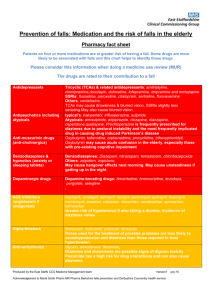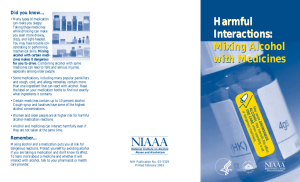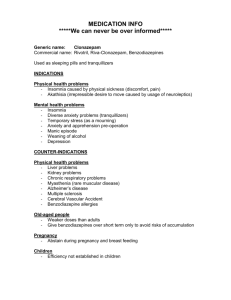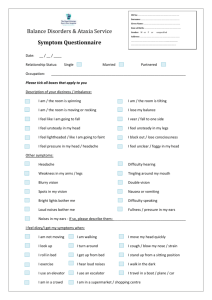Falls Traffic Light Chart
advertisement
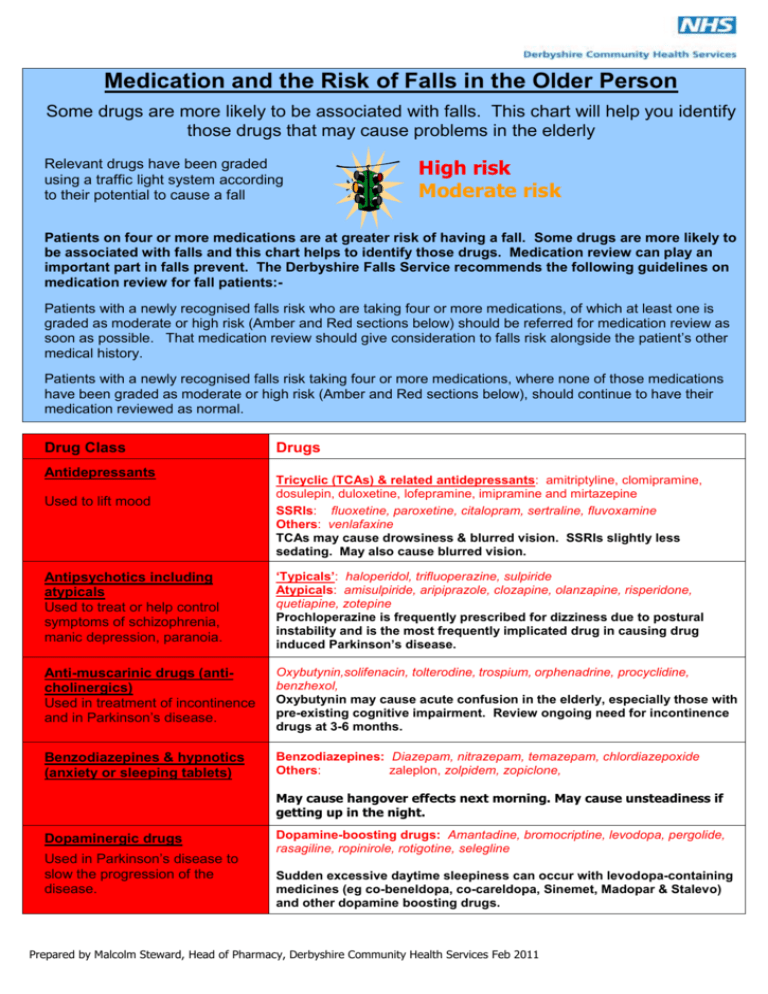
Medication and the Risk of Falls in the Older Person Some drugs are more likely to be associated with falls. This chart will help you identify those drugs that may cause problems in the elderly Relevant drugs have been graded using a traffic light system according to their potential to cause a fall High risk Moderate risk Patients on four or more medications are at greater risk of having a fall. Some drugs are more likely to be associated with falls and this chart helps to identify those drugs. Medication review can play an important part in falls prevent. The Derbyshire Falls Service recommends the following guidelines on medication review for fall patients:Patients with a newly recognised falls risk who are taking four or more medications, of which at least one is graded as moderate or high risk (Amber and Red sections below) should be referred for medication review as soon as possible. That medication review should give consideration to falls risk alongside the patient’s other medical history. Patients with a newly recognised falls risk taking four or more medications, where none of those medications have been graded as moderate or high risk (Amber and Red sections below), should continue to have their medication reviewed as normal. Drug Class Antidepressants Used to lift mood Drugs Tricyclic (TCAs) & related antidepressants: amitriptyline, clomipramine, dosulepin, duloxetine, lofepramine, imipramine and mirtazepine SSRIs: fluoxetine, paroxetine, citalopram, sertraline, fluvoxamine Others: venlafaxine TCAs may cause drowsiness & blurred vision. SSRIs slightly less sedating. May also cause blurred vision. Antipsychotics including atypicals Used to treat or help control symptoms of schizophrenia, manic depression, paranoia. ‘Typicals’: haloperidol, trifluoperazine, sulpiride Atypicals: amisulpiride, aripiprazole, clozapine, olanzapine, risperidone, quetiapine, zotepine Prochloperazine is frequently prescribed for dizziness due to postural instability and is the most frequently implicated drug in causing drug induced Parkinson’s disease. Anti-muscarinic drugs (anticholinergics) Used in treatment of incontinence and in Parkinson’s disease. Oxybutynin,solifenacin, tolterodine, trospium, orphenadrine, procyclidine, benzhexol, Oxybutynin may cause acute confusion in the elderly, especially those with pre-existing cognitive impairment. Review ongoing need for incontinence drugs at 3-6 months. Benzodiazepines & hypnotics (anxiety or sleeping tablets) Benzodiazepines: Diazepam, nitrazepam, temazepam, chlordiazepoxide Others: zaleplon, zolpidem, zopiclone, May cause hangover effects next morning. May cause unsteadiness if getting up in the night. Dopaminergic drugs Used in Parkinson’s disease to slow the progression of the disease. Dopamine-boosting drugs: Amantadine, bromocriptine, levodopa, pergolide, rasagiline, ropinirole, rotigotine, selegline Sudden excessive daytime sleepiness can occur with levodopa-containing medicines (eg co-beneldopa, co-careldopa, Sinemet, Madopar & Stalevo) and other dopamine boosting drugs. Prepared by Malcolm Steward, Head of Pharmacy, Derbyshire Community Health Services Feb 2011 Drug Class Drugs ACE Inhibitors /angiotensin II antagonists captopril,, enalapril, lisinopril, ramipril, perindopril, quinapril, fosinopril, trandolapril, losartan, valsartan. irbesartan, candesartan, eprosartan, telmisartan Used to treat hypertension, heart failure and following a heart attack. Greater risk of hypotension if taking a diuretic, incidence of dizziness varies Alpha-blockers Used in men to treat enlarged prostate gland, may be used to treat hypertension. Alfuzosin, doxazosin, indoramin, prazosin, tamulosin, terazosin Anti-arrhythmics digoxin, amiodarone, flecainide, Drugs used to control how the heart beats and to help keep its rhythm. Dizziness and drowsiness are possible signs of digoxin toxicity Flecainide has a high risk for drug interactions and can also cause dizziness Doses used for treatment prostate problems are less likely to cause hypotension and dizziness than those required to treat hypertension. Beta-blockers Used to treat hypertension, angina, heart irregularities and after heart attack. atenolol, bisoprolol, metoprolol, nebivolol, acebutolol oxprenolol, propranolol, carvedilol, sotalol Diuretics Used to treat hypertension, heart failure and fluid retention. bendroflumethiazide, chlortalidone, cyclopenthiazide, indapamide, metolazone, furosemide, bumetanide. amiloride, triamterene, spironolactone. Anti-epileptics (anticonvulsants) These drugs help people with epilepsy to lead a normal life by reducing fit frequency and reduce the possibility of brain damage. carbamazepine, clonazepam, gabapentin, lamotrigine, phenobarbital, phenytoin, pregabalin, sodium valproate, topiramate, vigabatrin. Anti-histamines Used in hay-fever, itching and to control nausea, vomiting, and vertigo. Those most likely to cause drowsiness include: chlorpheniramine, diphenhydramine & promethazine, Others include: loratidine, desloratidine, cetirizine, cinnarizine, levocetirazine Calcium channel blockers Used in hypertension & angina. diltiazem, verapamil, amlodipine, felodipine, lacidipine, nifedipine, May cause dizziness or fatigue Nitrates Used to ease angina. glyceryl trinitrate, isosorbide mononitrate & dinitrate. Opiate analgesics Used to relieve moderate to severe pain. Buprenorphine, codeine, co-codamol, co-dydramol, diamorphine, dihydrocodeine, fentanyl, morphine, tramadol. Drowsiness and sedation common when starting treatment. Confusion reported with tramadol. Reports of dizziness may be due to postural hypotension Can cause dehydration, dizziness, confusion and postural hypotension phenytoin side effects such as dizziness, blurred vision etc. may be signs of drug related toxicity. carbamazepine incidence of dizziness, drowsiness and blurred vision are dose related side effects Risk of hypotension with cinnarizine is a dose related, short term use where possible. Dizziness may be due to postural hypotension. Using this Medication Chart in Conjunction with Falls Risk Assessment For the purposes of carrying out a falls risk assessment:● Where a patient is taking four or more medications, but none of those medications is graded as moderate or high risk (Amber and Red sections above) the patient should be given a negative rating for the risk factor. ● Where a patient is taking four or more medications and one or more of the patient’s medications is graded as moderate or high risk (Amber and Red sections above) the patient should be given a positive rating for the risk factor. NB: If you have any doubt as to whether or not any medications being taken by a patient belong to any of the drug families graded as moderate or high risk (Amber and Red sections above), and that patient is taking four or more medications you should give that patient a positive rating. Prepared by Malcolm Steward, Head of Pharmacy, Derbyshire Community Health Services Feb 2011 Prepared by Malcolm Steward, Head of Pharmacy, Derbyshire Community Health Services Feb 2011



